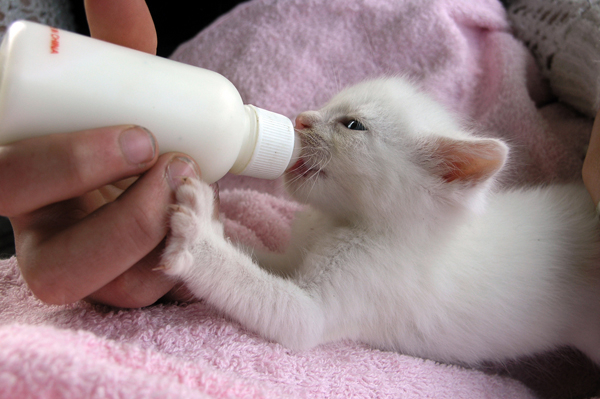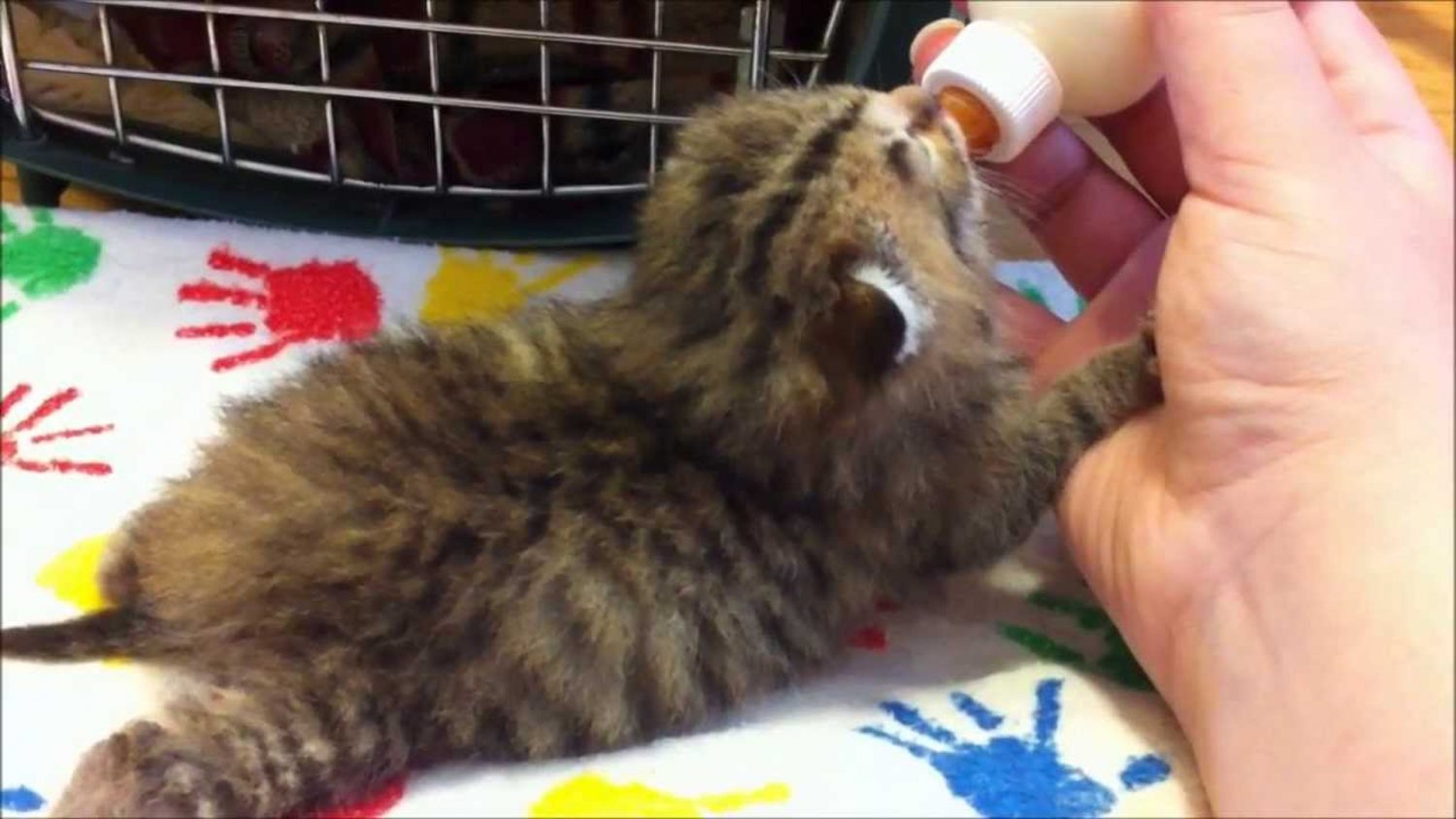First, Cleanliness
Young kittens must be protected from disease!! ALWAYS wash your hands before and after handling the kittens, and ALWAYS clean bedding and towels, and sterilize your bottles, nipples, brushes, or tube feeders in boiling water after each use!! If your kittens did not receive their mother’s colostrum (the watery milk the queen produces in the first couple of days after giving birth), your kittens are at an even higher risk as they did not receive the antibodies present in the colostrum. In that case, be sure to keep them separated from any other animals, also.
Housing
House your kitten(s) in a small room. A bathroom is perfect. At first they’ll only need an area for their bed. Then, as they grow, they’ll need areas for their food and litter box.
First and foremost, kittens need to be kept warm and free from drafts. If not they can suffer hypothermia very quickly. A small box is perfect. Place towels in the box to create a cozy “nest.” You can place towels over the box (if needed) to keep the inside warmer. The bedding towels should be replaced frequently; immediately when wet. A heating pad – on low setting – can be placed under half of the area. This gives the kitten(s) the option of how much heat they require. Kittens need plenty of sleep, so the area that they’re in should encourage this.

Bottle Feeding
Bottle feeding a kitten requires special nursers (bottle with nipple) designed for hand-feeding kittens. Make sure the kitten is on its stomach, even if it’s in your lap or on your tummy. DO NOT turn the kitten on its back to bottle feed, as this will cause the kitten to aspirate and possibly drown in the formula.
Nipple of bottle: poke a small hole in the nipple with a very fine needle. Once the mixture is inside the bottle, turn the bottle over (nipple facing down) and gently squeeze. The formula should drip out but not run out. If the kitten gets too much formula too fast it can aspirate. Increase the hole size accordingly.
Gently insert the nipple into the mouth of the kitten then slowly pull up and forward on the bottle so that the kitten will have its head slightly elevated and extended while nursing. Be sure the kitten is actually suckling by checking the level of formula in the nurser bottle and check the sides of the kitten’s mouth for excess formula.
If the kitten doesn’t take the bottle, mix the formula with wet food and make a soup/slurry. This should interest the kitten. If not, make sure there’s wet & dry food and water available all of the time.
How much to bottle feed the kittens?
It’s better to under-feed than over-feed a kitten in the first few days. A bottle-fed kitten will usually stop nursing when it’s full. If, however, you notice milk coming out of its nose, the milk is being delivered too fast, which means that the hole in the nipple is too large. (If the kitten continues to bubble its formula out of its nose each feeding, call us and we’ll have our vet check the kitten carefully to be sure the inside palate are of its mouth has fully developed.)
Formula Temperature
You should warm the formula before giving it to the kitten, to 99°-101°F (the body temperature of cats). The best way to do this is by putting the sterilized bottle into a warm bowl of water rather than using the microwave, which can cause “hot spots” in the formula.
Bottle vs. Syringe
Some kittens just won’t suck formula from a nippled bottle. In this case you should use a plastic syringe (without the needle of course!). From the newborn stage until the kittens are about 1-1/2 weeks old, use a 3 cc. syringe, and feed every 2 hours. At 1-1/2 weeks old, they are ready for the 6 cc. syringe size and feeding every 3 hours, and at about 3 weeks old, move them up to a 12 cc. syringe, feeding them at least every 4 hours. An average meal for a 3 week old kitten can vary from a single syringe full (12 fluid cc) to three syringes full (36 fluid cc) for a large and hungry kitten!!!
Formula
We use the powdered form of KMR (Kitten Milk Replacer) formula. While the powdered form is more economical, it does not always reconstitute as lump-free as needed to flow through the syringes. So make sure that the formula is thoroughly dissolved before feeding. We also recommend mixing the formula with goat milk instead of water – one part KMR to two parts goat’s milk. DO NOT USE COW MILK! This ensures that the kitten is getting all the needed vitamins, nutrients and minerals it needs to grow strong. You can buy goat’s milk at any grocery store.
How much formula to give?
Normally, it’s recommended that you give 2 tablespoons of liquid formula for every 4 ounces of body weight per day. For very young kittens, you’ll need to divide their total daily amount into six equal sized feedings. And yes, this does mean during the night, also! As the kittens grow, the number of feedings and their frequency can be decreased. Also as they grow, they can let you know better when they are actually hungry. Kittens that are not getting enough nourishment may cry continuously, suck on each other or on themselves, and they may have prominent hips or backbones.
Do I need to burp the kitten?
After each feeding, you’ll need to hold the kitten against your shoulder and gently burp it. Another technique is to hold the kitten so its back is against your chest and gently cuddle it under your neck while rubbing its tummy. A steady weight gain of about 10 grams (or 1/3 of an ounce) per day is recommended, but do not be surprised if a kitten may stay at the same weight for a day or two, then suddenly the weight gains are seen. After feeding, burping and weighing the kitten, check to see if the kitten’s bedding needs to be changed, and that the temperature is correct. Then, put the kitten back in the box so that it can sleep. A properly fed kitten will sleep through to the next feeding.
Stimulating Elimination
If properly fed, kittens will have a couple of firm, yellowish stools per day. Also after each feeding, you will need to gently massage and stimulate the anal and genital area with a sterile cotton ball or piece of gauze dipped in warm water. This will cause the kitten to urinate and have bowel movements, and it is very important that you continue to do this for the kitten until it is definitely using the litter box on its own, even though most kittens can control their own bowel movements at about 10 days old. The skin area is very delicate and may become raw or sore from your efforts. If this happens, apply a tiny dab of Preparation H ointment to the affected area after each stimulation. Keep in mind that your kitten will probably not have a bowel movement every feeding, and sometimes even skip a day. This should be fine as long as the kitten is growing, eating well, not showing any signs of distress, and urinating.
Litter Box – Use a non-clumping litter
Eventually, kittens will need a litter box. This usually happens when they start eating solid foods. A box with shallow sides is best. Some kittens learn to use the litter box on their own. Some you’ll need to teach. After they’ve eaten, place them in the box. They’ll learn to use the litter box very quickly after a few “lessons.” Make sure to keep the litter box as clean as possible, especially if you have multiple kittens. Disease spreads quickly in communal boxes.
Socialization
Socializing is an important aspect of foster care. A well socialized kitten finds a home faster than one that hides in the back of their cage. Newborn to 4 week-old kittens should be handled daily; but only for a short period of time. Kittens this age are easily fatigued. At 4 weeks of age they’ll begin to come to you for attention.
Questions/Concerns
Email us any time if you have questions, concerns or problems with your kitten(s). If it’s an emergency please go to your vet.







